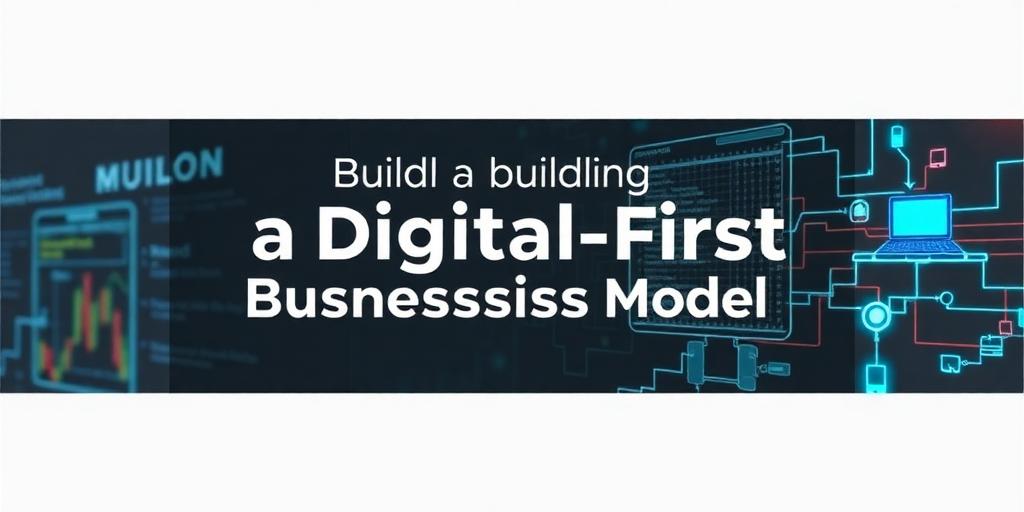Building a Digital-First Business Model: A Comprehensive Guide
In today's rapidly evolving business landscape, a digital-first approach is no longer optional but essential for sustained growth and competitive advantage. This article provides a detailed roadmap for establishing and optimizing a digital-first business model, covering key strategies, technologies, and best practices.
What is a Digital-First Business Model?
A digital-first business model prioritizes digital channels and technologies across all aspects of the organization, from customer engagement and operations to product development and internal processes. Unlike traditional businesses that may simply add digital components, a digital-first company is built with digital at its core.
Key Components of a Digital-First Business Model
Customer-Centric Digital Experience:
- Personalization: Utilize data analytics to tailor customer experiences based on individual preferences and behaviors.
- Omnichannel Presence: Ensure a seamless experience across all digital touchpoints, including websites, mobile apps, social media, and email.
- User Experience (UX) Optimization: Continuously refine user interfaces to enhance usability and satisfaction.
Data-Driven Decision Making:
- Analytics Infrastructure: Implement robust analytics tools to capture and analyze customer data, market trends, and operational metrics.
- Key Performance Indicators (KPIs): Define and monitor KPIs to measure the effectiveness of digital initiatives and inform strategic decisions.
- A/B Testing: Conduct A/B tests to optimize website content, marketing campaigns, and product features.
Agile and Scalable Technology Infrastructure:
- Cloud Computing: Leverage cloud services for scalable computing power, storage, and software solutions.
- API-First Architecture: Design systems with APIs to facilitate seamless integration and interoperability with third-party services.
- Automation: Automate repetitive tasks and processes to improve efficiency and reduce operational costs.
Digital Marketing and Sales Strategy:
- Search Engine Optimization (SEO): Optimize website content to improve search engine rankings and organic traffic.
- Content Marketing: Create valuable and engaging content to attract and retain customers.
- Social Media Marketing: Utilize social media platforms to build brand awareness, engage with customers, and drive sales.
- Email Marketing: Implement targeted email campaigns to nurture leads and promote products or services.
- Paid Advertising: Utilize paid advertising channels, such as Google Ads and social media ads, to reach a wider audience and generate leads.
Digital-First Organizational Culture:
- Innovation: Foster a culture of innovation and experimentation to drive continuous improvement.
- Collaboration: Encourage collaboration and knowledge sharing across departments to break down silos.
- Training and Development: Invest in training and development programs to equip employees with the skills needed to thrive in a digital environment.
Implementing a Digital-First Business Model: A Step-by-Step Approach
Assess Current Digital Maturity:
- Evaluate the current state of digital capabilities across the organization.
- Identify areas for improvement and prioritize initiatives based on potential impact.
Develop a Digital Strategy:
- Define clear goals and objectives for the digital transformation.
- Outline specific strategies and tactics for achieving those goals.
- Develop a roadmap for implementing digital initiatives over time.
Invest in Technology and Infrastructure:
- Select and implement the technologies and infrastructure needed to support the digital strategy.
- Prioritize solutions that are scalable, flexible, and easy to integrate with existing systems.
Build a Digital-First Team:
- Recruit and retain talent with the skills and experience needed to drive digital transformation.
- Provide ongoing training and development to ensure employees stay up-to-date with the latest digital trends and technologies.
Continuously Monitor and Optimize:
- Track key performance indicators (KPIs) to measure the effectiveness of digital initiatives.
- Analyze data to identify areas for improvement and optimize performance over time.
Challenges and Considerations
- Security and Privacy: Implementing robust security measures to protect customer data and prevent cyber threats is paramount.
- Change Management: Successfully transitioning to a digital-first model requires effective change management strategies to overcome resistance and ensure buy-in from employees.
- Data Silos: Breaking down data silos and integrating data across different systems is crucial for gaining a holistic view of customer behavior and business performance.
Conclusion
Building a digital-first business model is a strategic imperative for organizations seeking to thrive in the digital age. By prioritizing digital channels, leveraging data-driven insights, and fostering a culture of innovation, businesses can enhance customer experiences, improve operational efficiency, and achieve sustainable growth. The journey towards digital transformation requires careful planning, investment, and continuous optimization, but the rewards are well worth the effort.









